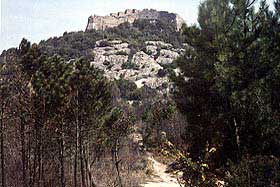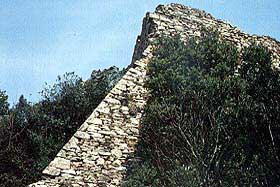Verruca Fortress
 |
 |
| On the vertex of the Mount Verruca rise the ruins of the fortress. | The southwest point of the walls. |
The fortress of the Verruca rises in the council of Vicopisano, province of Pisa, on the top of the Mount Verruca. It can be reached following the Speedway Florence-Pisa, exit toward Cascina, from here continuing toward Caprona. Here it is necessary to leave the car and to continue by foot on a path in the wood that conducts us under the walls of the fortress.
The Fortress or Rocca of the Verruca crowns the homonym mountain a quote of about 540 meters. Its origin and history are connected to those of the town of Calci, that rises at the center of the underlying valley. Calci has always been deeply tied up to the neighbor and powerful city of Pisa and to all the wars that interested it during the centuries.
The documented history of the settlements of the zone departed from the year 780. The territory was defended since that time from a fortress situated in the place of the future Rocca, ideal position to control the river Arno and its lowland up to the sea. For this reason the fortress of the Verruca has constituted always an impregnable stronghold for all the armies and the political powers interested to the conquest and control of this territory. A lot of famous and bloody battles were fought in the 'calcesano': in 1288 between Pisane Guelphs and the Lucchese army, in the 1328 there was the German invasion of Ludovico of Bavaria, in the 1363 the Florentine invasion, in the 1369 invasion of the troops of Charles IV of Bohemia and in the 1375 of those of the English captain of fortune John Hawkwood (Giovanni Acuto). In the 1402 Pisa was conquered by the Florentines and the Verruca Fortress, last rampart of resistance, was conquered and destroyed to avoid that it will return to be a threat. In the 1503 Pisa rose up and the war interested again the Fortress. The Florentine troops were forced to regain the Verruca, fulcrum of the hostile resistance. The surrender happened, not after a long and bloody siege, the 18th June of the same year and it was the end for the hopes of independence of Pisa that capitulated definitely in hands Florentine six years later.
The actual aspect of the Fortitude is what derived from the works of strengthening performed after these war facts. The Verruca is a non homogeneous construction because of the different phases and of the different authors that took care of it. The first thing that can be noticed is that its walls are one of the few examples of bastions performed with melted stone to the place of the characteristic bricks used at the time for these kind of works. The cut stones are used only for the angles and in reduced quantity. In general the construction was performed with scarce care and without the usual respect of the proportions, with an excessive hurry caused by the necessity to make defensible this neuralgic point with the purpose of the definitive subjugation of the Pisa.
The principal front has cylindrical towers to the two extremities, attributed at the school of the Francione to the architect Luca del Caprina. The principal entry is opened at the extreme left of the front. The bastion of northwest, the worse performed, is instead attributed to Antonio da Sangallo. The most anomalous part is the west angle: it has a polygonal point and it possesses only the northern side. In the interior of the enclosure come out a crag of stone and a palace in state advanced degrade.
The scarce quality of the construction and the centuries of abandonment have done that the Fortress result today in a disastrous condition, invaded from the vegetation and to perennial risk of ulterior structural yielding. It can be reached, not easily, following a path from Caprona or from Vicopisano.
| Back to Homepage |
| Back to Castles Index |